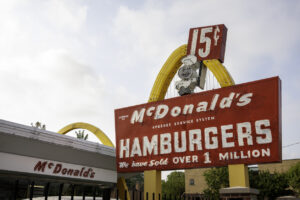In decisions that may signal things to come for employee plaintiffs in the wake of the Supreme Court’s decision in Alston,[1] two federal courts applying the rule of reason have denied class certification in two pending no-poach antitrust franchise claims for a failure to show the predominance of common questions. On July 28, a Chicago federal judge declined to certify a class action against McDonald’s for violating Section 1 of the Sherman Act.[2] Two days later, a Southern District of Illinois judge also declined to certify a class against Jimmy John’s due to several Rule 23(a) and (b) failures of proof, including the predominance of individual questions.[3]
Both class actions challenged no-poach clauses in the fast food giants’ franchise agreements, which prevented their franchisees from hiring employees of other franchises or company-operated restaurants. Although the courts denied class certification on varied bases, both found that the alleged unlawful restraint — the no-poach provisions — should be evaluated under the rule of reason and not the quick-look analysis sought by the plaintiffs, and the plaintiffs who sought to certify nationwide classes did not present evidence that the relevant geographic market where they offered their labor services was national in scope. The courts suggested instead that the relevant geographic markets for fast-food employees like the plaintiffs could be the hundreds or thousands of markets near where the employees lived and worked, and that they would include all quick-service restaurants in the markets, not just the defendants’ branded restaurants.
Background
Until July 2018, both McDonald’s and Jimmy John’s had provisions in their franchise agreements generally prohibiting their franchisees from employing or seeking to employ individuals who work for other franchisees or restaurants operated by the company. While most of the fast-food giants’ branded restaurants are franchised, they both operate a small portion of the restaurants themselves. The plaintiffs in Deslandes v. McDonald’s and Conrad v. Jimmy John’s Franchise LLC are current or former employees of McDonald’s and Jimmy John’s restaurants, who allege that the no-poach provisions violate Section 1 of the Sherman Act by limiting competition and suppressing their wages.
While the proposed classes — nationwide classes of all persons employed at the defendants’ branded restaurants from roughly 2013 through July 12, 2018 — were sufficiently numerous under Fed. R. Civ. P. 23(a), both courts found, among other things, that common questions did not predominate under Rule 23(b)(3), thus barring certification. Although not discussed in this article, both courts denied class certification on other grounds factually specific to the claims raised in their respective cases.[4]
Rule of Reason v. Quick-Look Analysis
Before assessing whether common questions predominated, both courts decided whether the alleged anticompetitive effects should be analyzed using the rule of reason or a quick-look analysis. Relying on the Supreme Court’s recent decision in Alston, which involved a similar Section 1 Sherman Act claim against the NCAA and 11 Division 1 conferences for allegedly wielding monopsonist power in the market for student athletes, the courts held that a quick-look analysis applies only in rare situations, where the court has “considerable experience with the type of restraint at issue.”[5]
The McDonald’s court did not have enough experience with no-poach provisions in franchise agreements to say with confidence that the practice must always be condemned. Thus, with Alston as precedent, the McDonald’s court applied the rule of reason, as opposed to the quick-look analysis.
The Jimmy John’s court relied on Alston to answer the question it had punted at the motion to dismiss stage and found that the rule of reason applies “in this monopsony case challenging a nationwide franchise’s use of intrabrand restraints that were arguably ‘designed to help [the company] more effectively compete with other brands by ensuring cooperation and collegiality among franchisees, and by encouraging investment in training.’”[6] In addition to following the Supreme Court’s precedent in Alston, the Jimmy John’s court also found that the plaintiffs had failed to present common proof that will show that each franchisee conspired with Jimmy John’s to suppress labor mobility and wages.[7]
The rule of reason applied for several other important reasons. First, Defendant McDonald’s put forth sufficient evidence of the pro-competitive effects of the alleged restraint — preventing free riding and encouraging training — warranting the application of the rule of reason.[8] Second, because Defendant McDonald’s operates far fewer restaurants than its franchisees, franchises do not compete with restaurants McDonald’s operated for employees in many areas of the country, establishing that in many geographic markets, the restraints are vertical not horizontal.[9] Vertical restraints are judged under the rule of reason.[10] Third, Jimmy John’s presented expert opinion that the no-poach provision actually benefited the members of the putative class by encouraging their employers to invest in training, and the relevant labor market was not nationwide in scope and not limited to employment with the Jimmy John’s branded restaurants.[11] Rather, it encompassed employment at all quick-service restaurants within a local relevant market.[12]
Rule of Reason Application Creates Individual Questions Preventing Class Certification
The first question under the rule of reason analysis is whether the challenged restraint of trade has a substantial anticompetitive effect in the relevant market.[13] Both courts rejected the plaintiffs’ characterization of the relevant market as a national service market for McDonald’s or Jimmy John’s restaurant workers. The McDonald’s court said “it defies logic to suppose” that McDonald’s employees sell their labor in a national market.[14] According to the court, employees that compete in national markets are “highly skilled or highly paid” like CEOs — not fast-food employees.[15] This conclusion is buttressed by Defendant McDonald’s evidence: the deposition testimony from lay and expert witnesses demonstrated that McDonald’s restaurants experience local, not national, competition.[16] As such, the court found that proposed class members competed in different relevant geographic markets, making the rule of reason antitrust questions predominantly individual for purposes of Rule 23(b)(3).
Similarly, the Jimmy John’s court found, based on expert testimony, that competition from other quick-service restaurant employers and others would “push the worker’s wages … up to the competitive level associated with the worker’s skills.”[17] As such, individual questions as to whether individual plaintiffs suffered injury because of the alleged restraints existed, given the “varied and dynamic labor markets across the country.”[18]
Because the predominate question of whether the restraint causes an anticompetitive effect in the relevant market is not common to class members, the McDonald’s court did not decide whether the question of antitrust injury or impact is common.[19] But the court did say that it would be “difficult … to imagine that it could be a common question … ” since the question is based on wages, and “[t]he amount each person’s wages are suppressed,” which “will almost certainly vary depending on the amount of labor market power McDonald’s possessed in each relevant market.”[20]
Takeaways
While other courts could disagree,[21] these decisions represent big wins for employers and franchisors after the Alston decision, representing persuasive authority for limiting the use of quick-look analysis in franchise no-poach antitrust claims. Further, to the extent the rule of reason applies, the decisions illustrate the difficulty class plaintiffs and their counsel will face in trying to establish the predominance of common questions under the rule of reason when alleging both horizontal and vertical restraints.
[1] National Collegiate Athletic Association v. Alston, 594 U.S. ___.
[2] Deslandes v. McDonald’s USA LLC, No. 17 C 4857, 2021 WL 3187668 (N.D. Ill. July 28, 2021).
[3] Conrad v. Jimmy John’s Franchise LLC, No. 18-cv-00133-NJR, 2021 U.S. Dist. LEXIS 142272 (S.D. Ill. July 23, 2021).
[4] The McDonald’s court found the class was not fairly and adequately represented by counsel due to its litigation tactics, including waiving the right to pursue a rule of reason antitrust claim. The Jimmy John’s court denied class certification for a number of reasons beside predominance, including a failure of typicality and adequacy, and a class was not a superior method of adjudicating the claims.
[5] McDonald’s, 2021 WL 3187668 at *11 (quoting Nat’l Collegiate Athletic Ass’n v. Alston, 141 S. Ct. 2141, 2156 (2021)): Jimmy John’s, 2021 U.S. Dist. 142272, at 25-6 (quoting Nat’l Collegiate Athletic Ass’n v. Alston, 141 S. Ct. 2141, 2156 (2021)).
[6] Jimmy John’s, 2021 U.S. Dist. LEXIS 142272, at *35.
[7] Id. at *3-44.
[8] McDonald’s, 2021 WL 3187668 at *12-16. Even the plaintiffs’ experts echo this point, saying “for the restaurant employees in particular, the crew employees, there may be labor markets of different geographic size and that the key issue there might not even be size, it might be commuting distance.” Id. at 13.
[9] Id. at *16-17.
[10] Id. at *17.
[11] Jimmy John’s, 2021 U.S. Dist. LEXIS 142272, at *36-40.
[12] Id. at 39.
[13] McDonald’s, 2021 WL 3187668 at *18.
[14] Id. at *20.
[15] Id. at *21.
[16] Id. at *22-23.
[17] Jimmy John’s, 2021 U.S. Dist. LEXIS 142272, at *40 (quoting the defendant’s expert report).
[18] Id.
[19] McDonald’s USA LLC, 2021 WL 3187668 at *24 n. 6.
[20] Id.
[21] See e.g., Jarvis Arrington, et al v. BKW, et al., No. 20-13561 (11th Cir.). Oral arguments in the appeal of this franchise no-poach agreement case against Burger King have been scheduled for September 22, 2021.





